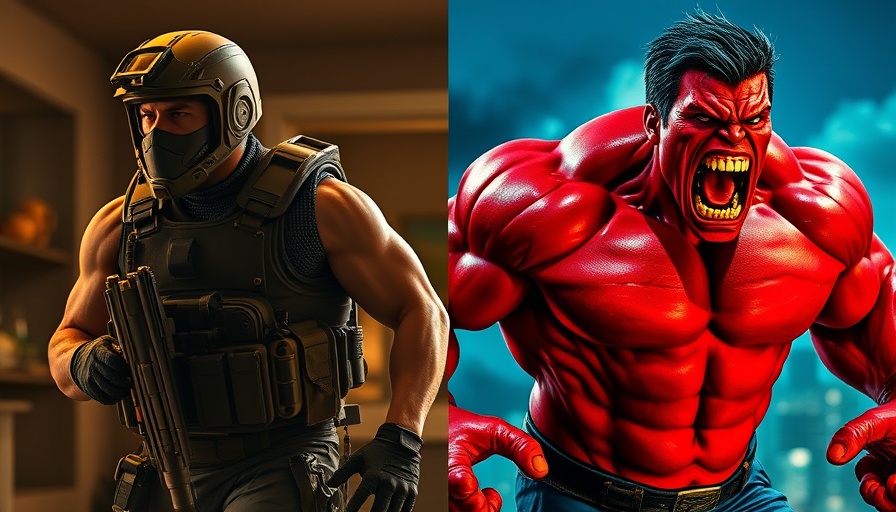
Unveiling the Alternate Reality of Marvel's Thunderbolts
The recent release of Thunderbolts has intrigued Marvel fans not just for its plot, but for the creative decisions that shaped its final form. As details emerge about the film's development, actor and writer Eric Pearson has shed light on a fascinating yet scrapped concept involving John Walker, also known as U.S. Agent, transforming into a Red Hulk. This idea, however, faced scrutiny and was ultimately discarded in favor of a different direction.
A Shifting Narrative: The Role of Valentina
According to Pearson, the initial script contained a substantial twist where Valentina, a manipulative character, would inject Walker with medication that served as a fail-safe to unleash his inner Red Hulk. This twist was meant to heighten the tension within the Thunderbolts team, where Walker’s aggressive nature could have led to a chaotic breakdown.
The idea was intriguing but not without its complications. Pearson noted, “The idea didn’t feel right.” Instead of pitting the team against a rampaging Hulk, the narrative aimed to explore a complex character evolution—showing Walker's struggle with his darker tendencies while driving home themes of redemption and teamwork.
The Sentry: A New Direction for Marvel's Anti-Heroes
With the Red Hulk concept shelved, the filmmakers turned to the character Sentry to fill the void. Pearson recalled discovering Sentry while participating in the Marvel Writers Program, noting its potential to embody the internal conflicts rife among anti-heroes. “What if Superman had a version of himself that was as bad as it was good?” Pearson pondered, suggesting that Sentry's narrative would further explore the “heroic ambition versus self-loathing” dichotomy that characterizes so many of Marvel's troubled heroes.
By opting for Sentry, Thunderbolts creators enriched the emotional complexity of the film, steering it away from a mere superhero showdown toward a more nuanced exploration of identity and morality.
Future Predictions: The Impact of Such Changes on Marvel's Cinematic Universe
As Marvel continues to navigate the evolving landscape of its cinematic universe, the decision to pivot from a Red Hulk to Sentry represents a significant moment of creative introspection. Fans are left to wonder: will more transformations take place, resulting in fresh perspectives and rich storytelling? The treatment of characters and their moral journeys will likely play a vital role in securing the success of future projects.
In a climate where superhero films often follow a predictable formula, the Marvel universe is at a crossroads, challenged to defy expectations and innovate. Pearson's insights suggest that the studio is committed to crafting stories that resonate on a deeper level, which could set the tone for many upcoming films.
The Broader Impact on Storytelling in Superhero Films
This exploration into what could have been with Thunderbolts highlights the broader trend in the superhero genre. As audiences yearn for more complex narratives, films need to reflect the moral ambiguities of their characters. Integrating layered characters like the Sentry can invite viewers into a more engaging experience, one where they navigate not just physical confrontations, but also the psychological battles within.
Current superhero films that lean on nuanced character arcs might indicate a shift in story focus—capturing audience interest while paving the way for deeper sentiment and thoughtful discourse. These changes are pivotal to ensuring that superhero cinema evolves, and it appears Marvel is steering in that direction.
Common Misconceptions and Myths about Red Hulk
Many fans may perceive the Red Hulk as merely a monstrous counterpart to the traditional Hulk, but there’s complexity in the character that often goes unrecognized. Red Hulk, or Thunderbolt Ross, was created with rich backstory elements that contribute to his motivations and inner conflicts.
The misconception might also stem from the belief that a Hulk character inherently must serve as an antagonist without deeper exploration into his psyche. The decision to move away from this trope in favor of developing the psychological complexity of characters speaks volumes about the aspirations of the modern superhero narrative.
The choices made during the creation of Thunderbolts highlight the industry's effort to break stereotypes and redesign tropes, opening the door to a more holistic representation of heroes in popular media.
The Importance of Character Development in Cinematic Adaptations
Ultimately, the narrative decisions surrounding Thunderbolts serve as a reminder of the importance of character development in adaptations. The exploration of human flaws within superhero stories not only enriches the plot but also reflects real-world conflicts that resonate with audiences.
The challenges faced in storytelling, such as including a character like the Red Hulk or choosing Sentry instead, underscore the complexities associated with adapting comic book lore to a film medium. It’s this careful navigation that ensures the richness of the story, making them not just another superhero flick but a deeply resonant film.
As Thunderbolts makes its way into the hearts of fans, we can only speculate what future projects will unveil—more meticulously crafted narratives or further exploration of the human condition through the lens of superhuman abilities.
Engage with the Marvel Narrative
Marvel fans continue to eagerly anticipate the evolution of their beloved franchises. Whether through watching Thunderbolts or discussing character arcs online, engagement with the narrative ensures that the stories remain vibrant. By actively participating in conversations around character development and the storytelling process, fans can help shape the direction of future Marvel films.
 Add Row
Add Row  Add
Add 




Write A Comment